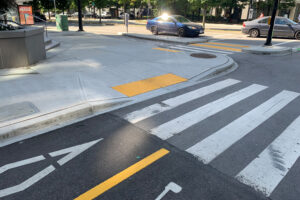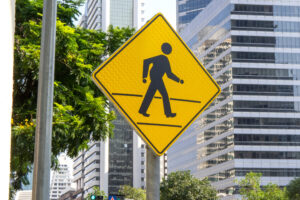In part one of our three-part series on improving traffic safety for all, we looked at the increase of road traffic crashes and their burden worldwide. In part two, we survey some of the comprehensive and integrated system approaches to making roads safer, such as the Safe System approach, and what they mean for transportation professionals.
When the United Nations (UN) proclaimed 2021-2030 to be the Second Decade of Action for Road Safety, it set the daunting goal of preventing at least 50 percent of road traffic deaths and injuries worldwide by 2030.
It had set the same goal to halve fatalities and injuries for the first Decade of Action for Road Safety from 2011-2020. However, by the end of those 10 years, the number of traffic-related fatalities and serious injuries had not decreased—in fact, as the decade closed, the numbers were again on the rise.
Yet, for nearly four decades, since the 1970s, the rates of traffic crash deaths and injuries had been in steady decline. That decline can be attributed to various factors: new safety features in motor vehicles, laws mandating seatbelt and helmet use, public campaigns about the dangers of impaired driving, and enforcement of speed limits. For the most part, these initiatives relied on individual road users to behave safely by adhering to rules.
As rates levelled off in the late 2000s, it became apparent that different means of improving traffic safety were needed. The new approaches that have emerged, which include the Safe System Approach and Complete Streets, recognize that road transport is a complex system that is evolving. Reducing—and ultimately eliminating—traffic-related fatalities and injuries requires multidisciplinary collaboration, with transportation and traffic professionals playing an instrumental role in these efforts.
The Safe System Approach and Vision Zero
When the UN declared the Second Decade of Action for Road Safety, it embraced the Safe System Approach, a relatively new concept that shifts a major share of the responsibility for safety from road users to those who oversee and design the road transport system. With the Safe System approach, responsibility is shared, meaning that a variety of professionals, from planners, designers, and engineers to policy makers, vehicle manufacturers, and public health professionals, all have a part in creating roadway environments that are safer for all users.
The Safe System approach has several other features that differentiate it from past initiatives. For example, key to the Safe System is that it places safety at its core. This is a significant shift because historically, road systems were planned and designed with efficiency in mind, with the goal of moving motor vehicles as quickly and smoothly as possible; safety was a secondary consideration. The Safe System approach advocates that safety should not be compromised for the sake of other factors such as cost or faster transport times.
And while in the past, traffic deaths were seen to be the inevitable consequence of road travel—the price paid for the increased mobility afforded by motor vehicles—the Safe System approach is based on the fundamental tenet that traffic crash deaths and serious injuries are unacceptable.
Also central to the Safe System is the concept that humans make mistakes. Additionally, they are vulnerable, meaning they have limits to the crash forces they can tolerate. Because people make mistakes and are vulnerable, all aspects of the road system, from policy development to the design and maintenance of infrastructure, should decrease the risk of serious mistakes, and ensure that inevitable mistakes don’t result in serious injuries or fatalities.
Within the Safe System framework, ensuring safety is a proactive process of continuous improvement, rather than a series of reactions to crashes that have occurred. It encourages planners, designers, and engineers to proactively identify and mitigate risks beforehand, and to do so over the entire system, not just at locations where there have been crashes. Building redundancy into the system is also essential, meaning that all parts of the system should be strengthened, so that if one fails, the other parts still serve to protect.
The Safe System approach emerges from, and is an extension of, Vision Zero, and the two terms are often used in conjunction with each other. Vision Zero is a strategy that was first implemented in Sweden in 1997. Its goal is to eliminate all traffic fatalities and severe injuries, while increasing safe, healthy, and equitable mobility for all.
Vision Zero is based on the idea that traffic crashes are preventable. And while it places particular emphasis on managing vehicle speeds, it does stress that, like the Safe System approach, traffic safety is not the sole responsibility of individual road users, but rather is shared by transportation system designers. It advocates for collaboration among diverse stakeholders and the use of data in understanding trends and making decisions. It also makes transportation equity a priority.
Putting the Safe System into action
The World Health Organization (WHO) has released a Global Plan for the Second Decade of Action for Road Safety. The plan focuses on five main areas of action:
- Implementing multimodal transport and land-use planning
- Building and operating safe road infrastructure
- Improving vehicle safety
- Ensuring safe road use
- Providing timely and appropriate post-crash response
Transportation and traffic planners, designers, and engineers play vital roles in many of these action areas. For example, the WHO emphasizes the development and operation of road infrastructure that enables multimodal mobility, including shared/public transport, walking, and cycling, and that eliminates or minimizes risks for all road users, especially the most vulnerable. And while ensuring safe road use involves setting and enforcing rules related to aspects like vehicle speed and the use of protective equipment, transportation professionals have a responsibility to design infrastructure that facilitates safe behaviors. This can involve creating clear road signage and markings, using roundabouts and other traffic calming designs, and physically separating road users through protected bicycle lanes and pedestrian only zones.
As well, operating safe road infrastructure involves undertaking crash-risk mapping and proactive safety assessment of road networks.
Many regions around the world have readily taken up the Safe System. The European Union (EU) has adopted the goal of achieving Vision Zero (zero deaths and injuries) by 2050. The EU Road Safety Policy Framework 2021-2030 sets the target, in line with the UN, of reducing fatalities and serious injuries by 50 percent by 2030; its framework for achieving this is based on the Safe System approach.
Similarly, the governments of Australia have committed to a vision of zero deaths and serious injuries by 2050 (Vision Zero) and to the Safe System.
In North America, Canada has adopted the Safe System approach for its Canadian Road Safety Strategy 2025. And in the United States, the National Roadway Safety Strategy, released by the US Department of Transportation (DOT) in 2022, has the Safe System approach as its guiding paradigm.
In support of that strategy, the US DOT has also created its Safe Streets for All (SS4A) program, which is providing $5 billion in grants over five years to support regional, local, and Tribal initiatives that prevent roadway deaths and serious injuries. The program supports Planning and Demonstration Grants as well as Implementation Grants.
Ensuring transportation equity and the safety of vulnerable road users
The US SS4A was established through the Bipartisan Infrastructure Law (formally known as the Infrastructure Investment and Jobs Act). As part of that legislation, all states are required to develop a Vulnerable Road User Safety Assessment as part of their Highway Safety Improvement Program (HSIP). These assessments involve identifying areas of high risk to vulnerable road users (VRUs) and determining improvements needed to mitigate safety risks.
This marks an important move towards acknowledging vulnerable road users in road safety plans. Quite often, people think of a traffic collision as involving two or more vehicles or a vehicle and an object. Yet, worldwide, more than 50 percent of collisions are between motor vehicles and those who are not in vehicles, such as pedestrians and cyclists. In the US, pedestrian deaths have reached a 40-year high, accounting for up to 20 percent of traffic crash fatalities. Cyclist deaths have increased 40 percent in the past decade. There have been similar increases in other countries too. In Europe’s urban areas, 52 percent of road fatalities involve pedestrians and cyclists, with high conflict areas between motorists and VRUs concentrated in urban and suburban settings.
Vulnerable road users are those who are not in a car, bus, or truck—generally considered to include pedestrians and cyclists—who have little to no protection from crash forces. They include people who have disabilities or reduced mobility, the elderly, and/or who use mobility aids. They also include young children, people using strollers, as well as the growing number of road users on mobility devices like e-scooters.
Statistics also show that being a person of color or from a lower socioeconomic background can make a road user more vulnerable. According to the World Health Organization, those from lower socioeconomic backgrounds are more likely to be involved in road traffic crashes. In the US, people in high poverty areas are 35 percent more likely to be hit and killed in crashes, compared to national average, and Black and American Indian people are killed by crashes at a much higher rate than other populations.
Quite often, high poverty regions or areas where there are concentrations of Black, Indigenous or other persons of color tend to be overburdened with roads designed for high volumes and high speeds. These same areas typically lack safety infrastructure for those walking or cycling, including limited crosswalks, connected sidewalks, streetlights, bikeways, and traffic calming measures.
Given that different communities are impacted differently, the US DOT’s Federal Highway Administration’s (FHWA) guidance on Vulnerable Road User Safety Assessments says states’ assessments should address equity by considering the impacts to those communities along with identifying areas that are high-risk to VRUs. This identification can be done through approaches like High Injury Network (HIN) analysis, which includes mapping corridors where high numbers of people have been killed and severely injured in traffic crashes—often in equity areas—or through predictive safety analysis, which helps identify roadway sites with the greatest potential for improvement.
Transportation equity, which ensures that safe and secure mobility is fair and enables all people to participate in socioeconomic life, has advantages beyond reducing traffic fatalities and injuries. Road systems that do not include safe spaces for walking, cycling, or access to public transit, limit people’s abilities to access life necessities, such employment and other economic opportunities, education, healthy food, and health care. Therefore, ensuring safe, equitable mobility has an important role in reducing poverty and other inequities. Encouraging walking and cycling also results in positive health outcomes for individuals, while also helping to improve air quality and mitigate the impacts of climate change overall.
Building Complete Streets
As part of its guidance on vulnerable road users, the US DOT FHWA “encourages States and communities to adopt and implement Complete Streets policies that prioritize the safety of all users in transportation network planning, design, construction, and operations.”
The term “Complete Streets” was first officially coined in 2003. It is an approach to planning, designing, and building streets that enables safe access for all users, including pedestrians, bicyclists, motorists, and transit riders of all ages and abilities, and emphasizes the needs of those who have experienced systemic underinvestment or whose needs have not been met through traditional approaches.
The FHWA says that a “Complete Streets Design Model includes careful consideration of measures to set and design for appropriate speeds; separation of various users in time and space; improvement of connectivity and access for pedestrians, bicyclists and transit riders, including for people with disabilities; and addressing safety issues through implementation of safety countermeasures.”
Often, Complete Streets projects have the effect of reducing the speed of motor vehicles. This is important, because speed is one of the biggest predictors of whether a collision results in an injury or death. Studies have shown that a pedestrian struck by a vehicle moving at 30 km/h (18.6 mph) has a 90-95 percent chance of surviving impact; when the speed increases to approximately 50 km/h (30 mph), that pedestrian has only a 50 percent chance of surviving.
Advocates for Complete Streets emphasize that they are both a process and an approach. A complete street might include sidewalks, bike lanes (or wide paved shoulders), special bus lanes, comfortable and accessible public transportation stops, frequent and safe crosswalks, median islands, accessible pedestrian signals, curb extensions, narrower travel lanes, roundabouts, and more. There is no singular way to create a Complete Street, because each one is unique and responds to its community context—its setting, be it rural, suburban, or urban, and the needs of its users.
While transportation and traffic professionals have many options in working to develop and maintain safer streets for all, the policy directives are clear: the time for action is now. In part three of our series, we’ll look at some of the tools that planners, designers, and engineers can use to put the Safe System and Complete Streets approaches into practice.




